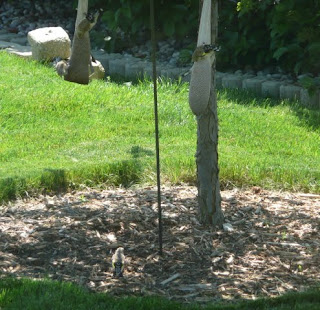Patient observers might note individual birds disappearing into tall chimneys during the breeding season. Chimney Swifts make a small nest of twigs, held together and glued with saliva to the inside wall of a chimney-like structure. Only one pair will nest per chimney or structure, but there may also be a few non-breeding swifts, some of which (usually young from a past year) may "help" the breeding swifts feed the young in the nest. Chimney Swifts use chimneys and similar structures outside the breeding season, too. During migration, especially in fall, many hundreds of swifts might use large chimneys to roost in overnight.
Prior to European settlement of North America, Chimney Swifts used hollow trees, caves, and narrow chasms. Their populations probably increased with the availability of human structures for nesting and roosting. However, in recent years Chimney Swift populations have undergone a dramatic decrease. In the U.S., this decline has been about 2.4% per year since the early 1980s; in Michigan the rate has been -1.5% annually (based on Breeding Bird Survey data).
Several factors are probably at play. Most important is a decrease in aerial insect prey, likely due to pesticide use, habitat loss, and a changing climate. Other species of birds that rely on aerial insects, such as Common Nighthawks and swallows, are also on the decline. Add to this a special problem for Chimney Swifts: chimney design has changed in modern times, with many chimneys being too narrow, or covered or lined, for swifts to use.
This has led many organizations and individuals to create artificial Chimney Swift nesting structures. This spring, Stephen Lisius constructed and erected one of these excellent towers behind the Environmental Interpretive Center as his Eagle Scout project.
Stephen designed the tower according to plans similar to the graphic above, which is available in the Chimney Swift Nest Site Research Project Information Handout (PDF). The tower was constructed off-site, and then erected onto a sturdy foundation that had been put in place the week before. Here's the tower in place:
The outside of the tower will be finished soon with weatherization wrap and shingles. Stephen also plans to install a camera, so if/when swifts discover and use the tower, we can see what's going on. We may have to be very patient -- some towers go for years before they are used. I'll keep you posted!
If you are interested in learning more about these towers or even seeing if you'd like to make one yourself, the book Chimney Swift Towers: New Habitat for America's Mysterious Birds
Meanwhile, you might consider one of the swift monitoring projects. The program called Swift Night Out is done each fall in the U.S. Bird Studies Canada has initiated a citizen swift monitoring program as well.
Chimney Swift photo by D. Irving under a Creative Commons license. Tower photo by Sara Cole, used by permission.















